Evaluating News Coverage: The Rohingya Refugee Crisis in Bangladesh
VerifiedAdded on 2023/06/09
|13
|2784
|371
Report
AI Summary
This report provides a comprehensive analysis of the Rohingya refugee crisis as portrayed in various news articles from sources such as ABC News, HuffPost, The Conversation, Aljazeera, and The Washington Post. The analysis focuses on the tone, angle, and content of these articles, highlighting the different perspectives on the crisis and its impact on both the refugees and the host country, Bangladesh. The report examines how each news outlet frames the story, whether from a localized point of view, a national perspective, or with a focus on specific issues like mental health or economic impact. While some articles emphasize the challenges faced by Bangladesh in hosting the refugees, others highlight the country's efforts in managing the crisis and providing support. Ultimately, the report concludes that while many news articles address the problem, they often lack practical solutions to the ongoing crisis.
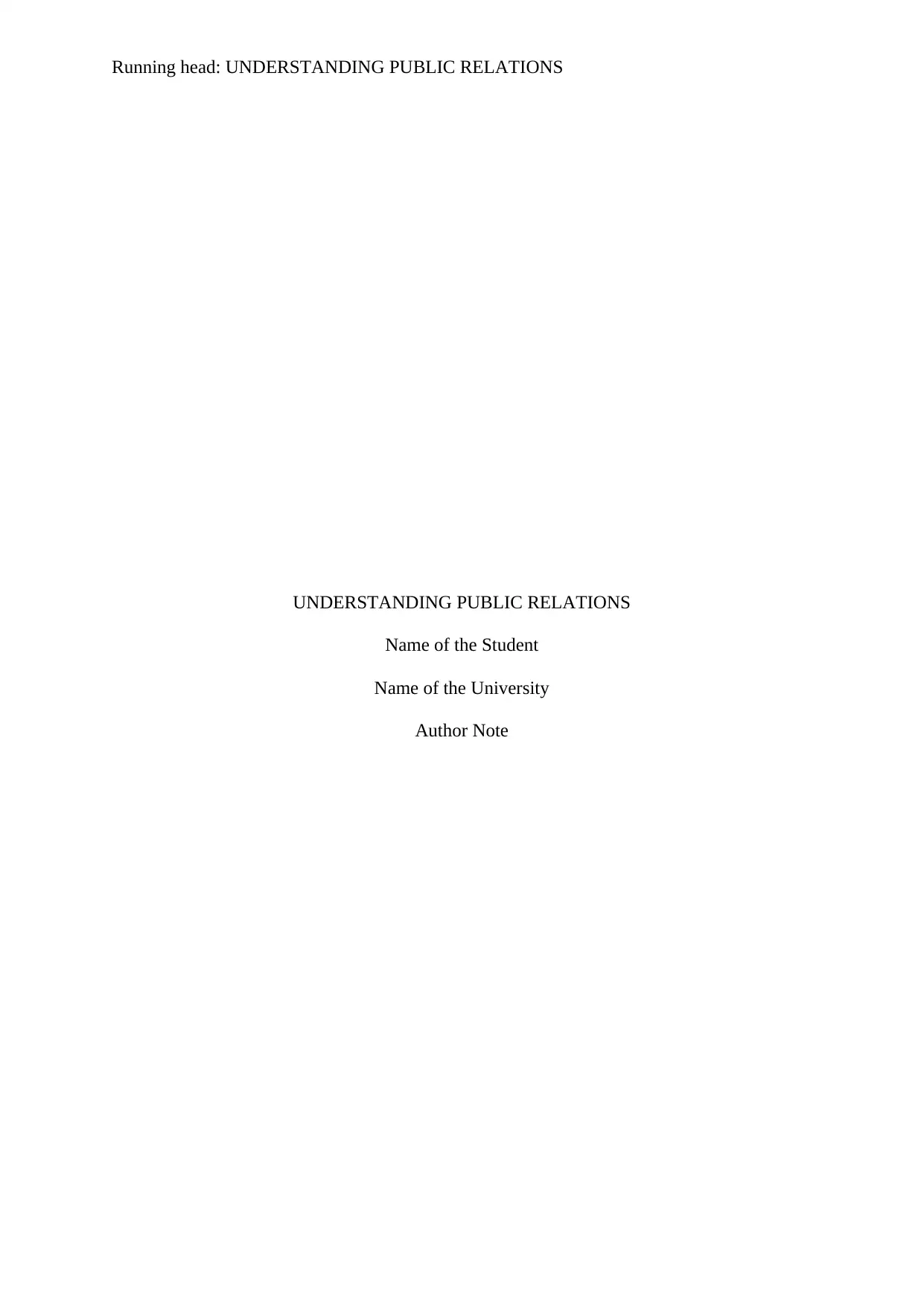
Running head: UNDERSTANDING PUBLIC RELATIONS
UNDERSTANDING PUBLIC RELATIONS
Name of the Student
Name of the University
Author Note
UNDERSTANDING PUBLIC RELATIONS
Name of the Student
Name of the University
Author Note
Paraphrase This Document
Need a fresh take? Get an instant paraphrase of this document with our AI Paraphraser
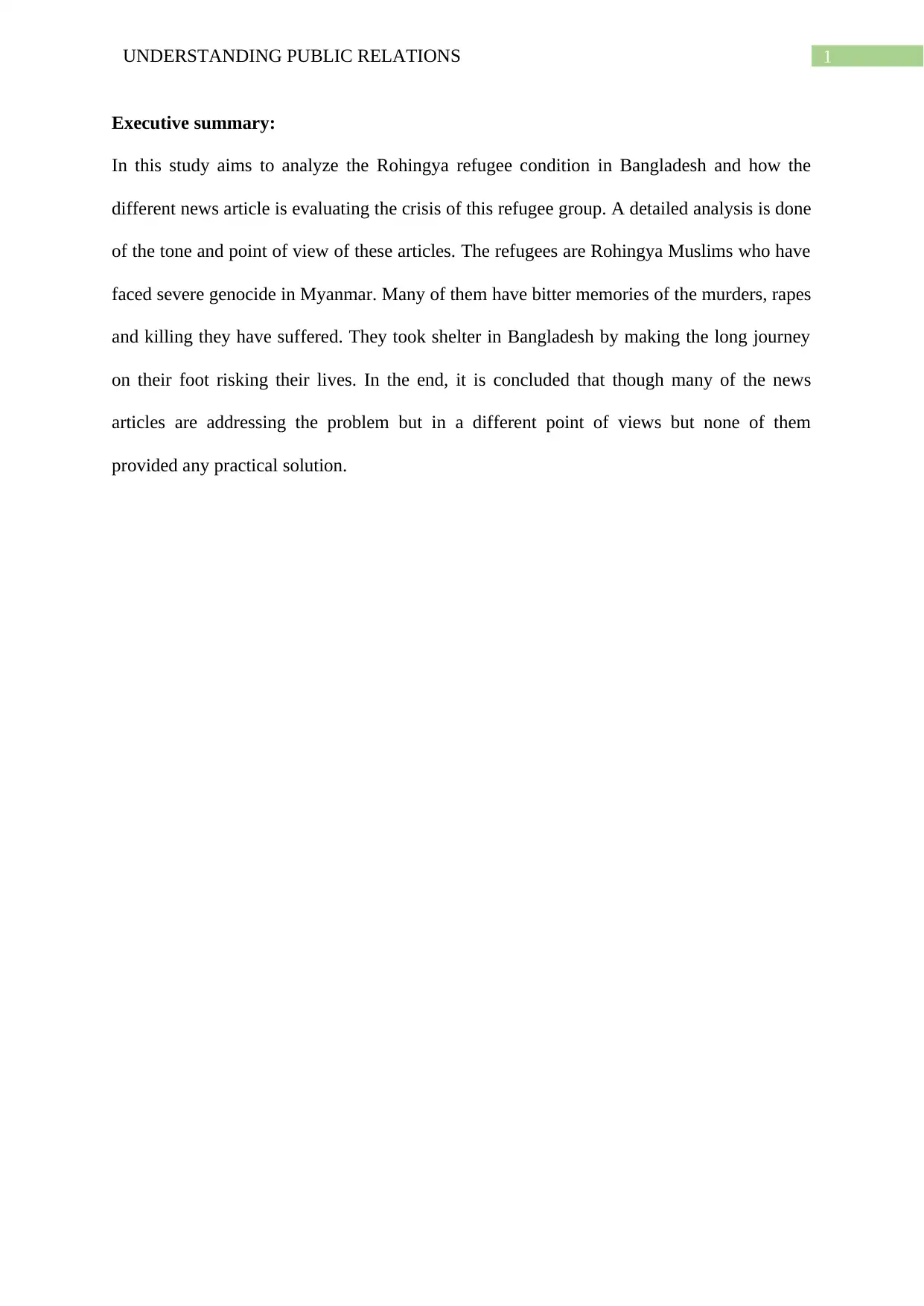
1UNDERSTANDING PUBLIC RELATIONS
Executive summary:
In this study aims to analyze the Rohingya refugee condition in Bangladesh and how the
different news article is evaluating the crisis of this refugee group. A detailed analysis is done
of the tone and point of view of these articles. The refugees are Rohingya Muslims who have
faced severe genocide in Myanmar. Many of them have bitter memories of the murders, rapes
and killing they have suffered. They took shelter in Bangladesh by making the long journey
on their foot risking their lives. In the end, it is concluded that though many of the news
articles are addressing the problem but in a different point of views but none of them
provided any practical solution.
Executive summary:
In this study aims to analyze the Rohingya refugee condition in Bangladesh and how the
different news article is evaluating the crisis of this refugee group. A detailed analysis is done
of the tone and point of view of these articles. The refugees are Rohingya Muslims who have
faced severe genocide in Myanmar. Many of them have bitter memories of the murders, rapes
and killing they have suffered. They took shelter in Bangladesh by making the long journey
on their foot risking their lives. In the end, it is concluded that though many of the news
articles are addressing the problem but in a different point of views but none of them
provided any practical solution.
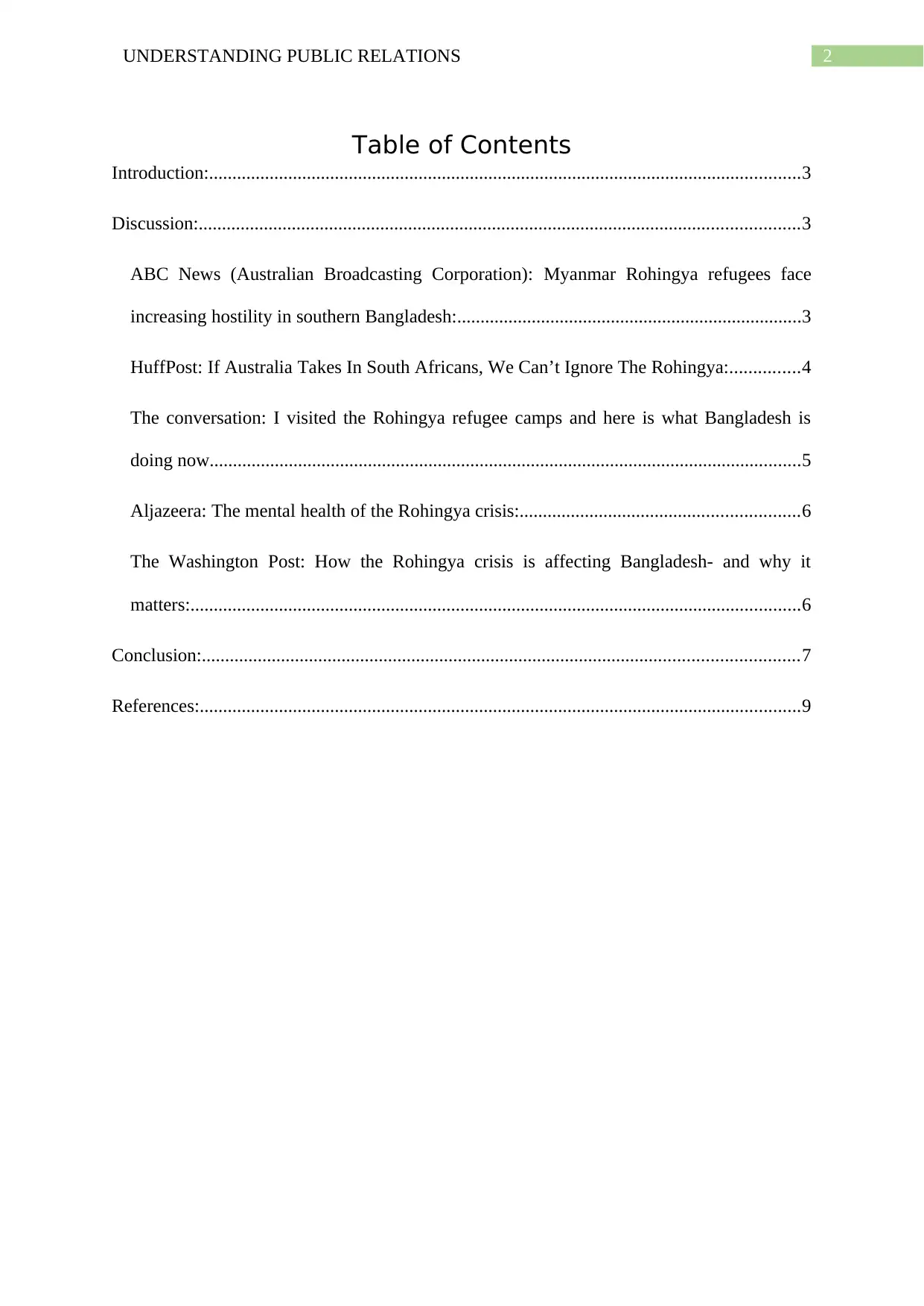
2UNDERSTANDING PUBLIC RELATIONS
Table of Contents
Introduction:...............................................................................................................................3
Discussion:.................................................................................................................................3
ABC News (Australian Broadcasting Corporation): Myanmar Rohingya refugees face
increasing hostility in southern Bangladesh:..........................................................................3
HuffPost: If Australia Takes In South Africans, We Can’t Ignore The Rohingya:...............4
The conversation: I visited the Rohingya refugee camps and here is what Bangladesh is
doing now...............................................................................................................................5
Aljazeera: The mental health of the Rohingya crisis:............................................................6
The Washington Post: How the Rohingya crisis is affecting Bangladesh- and why it
matters:...................................................................................................................................6
Conclusion:................................................................................................................................7
References:.................................................................................................................................9
Table of Contents
Introduction:...............................................................................................................................3
Discussion:.................................................................................................................................3
ABC News (Australian Broadcasting Corporation): Myanmar Rohingya refugees face
increasing hostility in southern Bangladesh:..........................................................................3
HuffPost: If Australia Takes In South Africans, We Can’t Ignore The Rohingya:...............4
The conversation: I visited the Rohingya refugee camps and here is what Bangladesh is
doing now...............................................................................................................................5
Aljazeera: The mental health of the Rohingya crisis:............................................................6
The Washington Post: How the Rohingya crisis is affecting Bangladesh- and why it
matters:...................................................................................................................................6
Conclusion:................................................................................................................................7
References:.................................................................................................................................9
⊘ This is a preview!⊘
Do you want full access?
Subscribe today to unlock all pages.

Trusted by 1+ million students worldwide
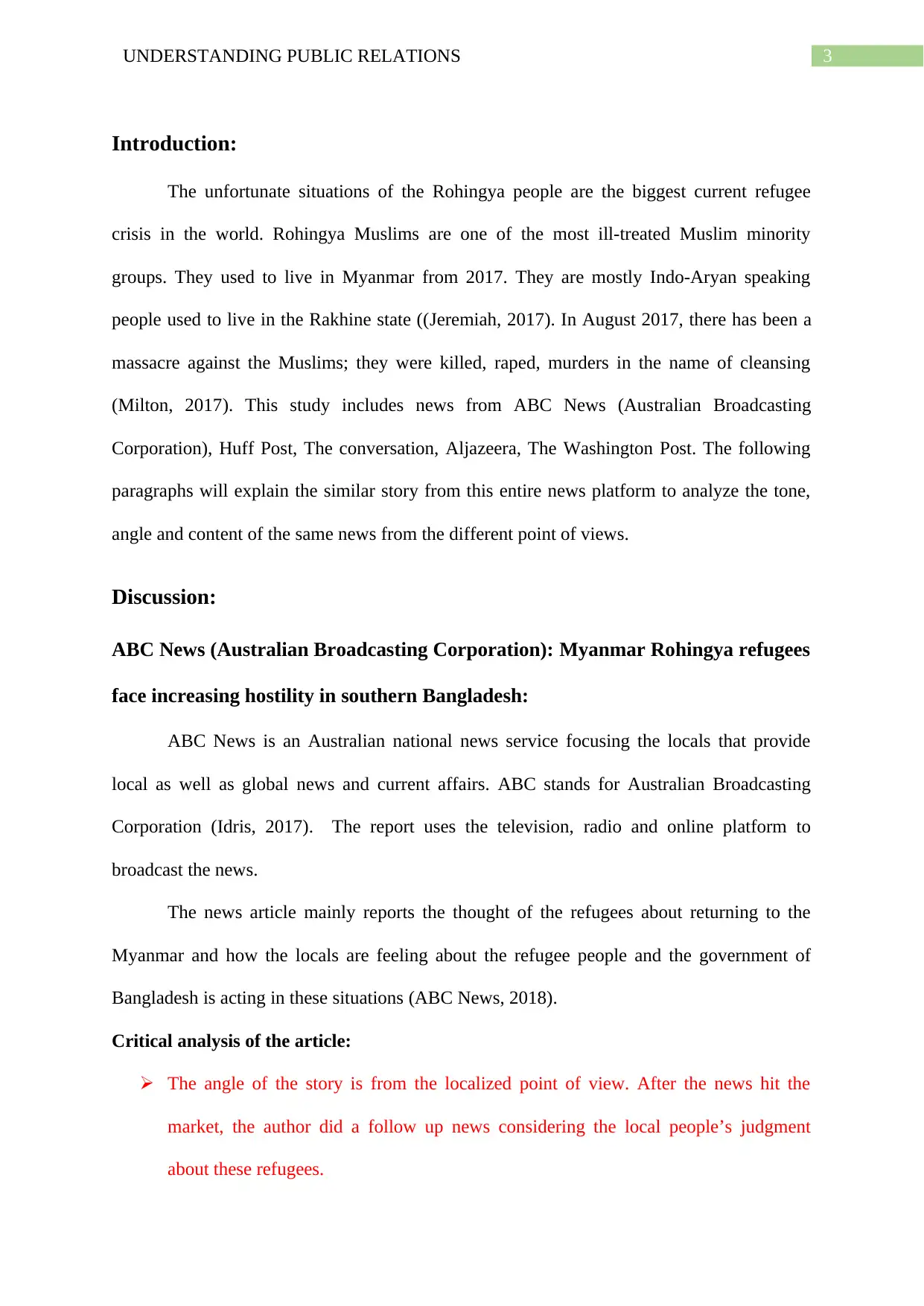
3UNDERSTANDING PUBLIC RELATIONS
Introduction:
The unfortunate situations of the Rohingya people are the biggest current refugee
crisis in the world. Rohingya Muslims are one of the most ill-treated Muslim minority
groups. They used to live in Myanmar from 2017. They are mostly Indo-Aryan speaking
people used to live in the Rakhine state ((Jeremiah, 2017). In August 2017, there has been a
massacre against the Muslims; they were killed, raped, murders in the name of cleansing
(Milton, 2017). This study includes news from ABC News (Australian Broadcasting
Corporation), Huff Post, The conversation, Aljazeera, The Washington Post. The following
paragraphs will explain the similar story from this entire news platform to analyze the tone,
angle and content of the same news from the different point of views.
Discussion:
ABC News (Australian Broadcasting Corporation): Myanmar Rohingya refugees
face increasing hostility in southern Bangladesh:
ABC News is an Australian national news service focusing the locals that provide
local as well as global news and current affairs. ABC stands for Australian Broadcasting
Corporation (Idris, 2017). The report uses the television, radio and online platform to
broadcast the news.
The news article mainly reports the thought of the refugees about returning to the
Myanmar and how the locals are feeling about the refugee people and the government of
Bangladesh is acting in these situations (ABC News, 2018).
Critical analysis of the article:
The angle of the story is from the localized point of view. After the news hit the
market, the author did a follow up news considering the local people’s judgment
about these refugees.
Introduction:
The unfortunate situations of the Rohingya people are the biggest current refugee
crisis in the world. Rohingya Muslims are one of the most ill-treated Muslim minority
groups. They used to live in Myanmar from 2017. They are mostly Indo-Aryan speaking
people used to live in the Rakhine state ((Jeremiah, 2017). In August 2017, there has been a
massacre against the Muslims; they were killed, raped, murders in the name of cleansing
(Milton, 2017). This study includes news from ABC News (Australian Broadcasting
Corporation), Huff Post, The conversation, Aljazeera, The Washington Post. The following
paragraphs will explain the similar story from this entire news platform to analyze the tone,
angle and content of the same news from the different point of views.
Discussion:
ABC News (Australian Broadcasting Corporation): Myanmar Rohingya refugees
face increasing hostility in southern Bangladesh:
ABC News is an Australian national news service focusing the locals that provide
local as well as global news and current affairs. ABC stands for Australian Broadcasting
Corporation (Idris, 2017). The report uses the television, radio and online platform to
broadcast the news.
The news article mainly reports the thought of the refugees about returning to the
Myanmar and how the locals are feeling about the refugee people and the government of
Bangladesh is acting in these situations (ABC News, 2018).
Critical analysis of the article:
The angle of the story is from the localized point of view. After the news hit the
market, the author did a follow up news considering the local people’s judgment
about these refugees.
Paraphrase This Document
Need a fresh take? Get an instant paraphrase of this document with our AI Paraphraser
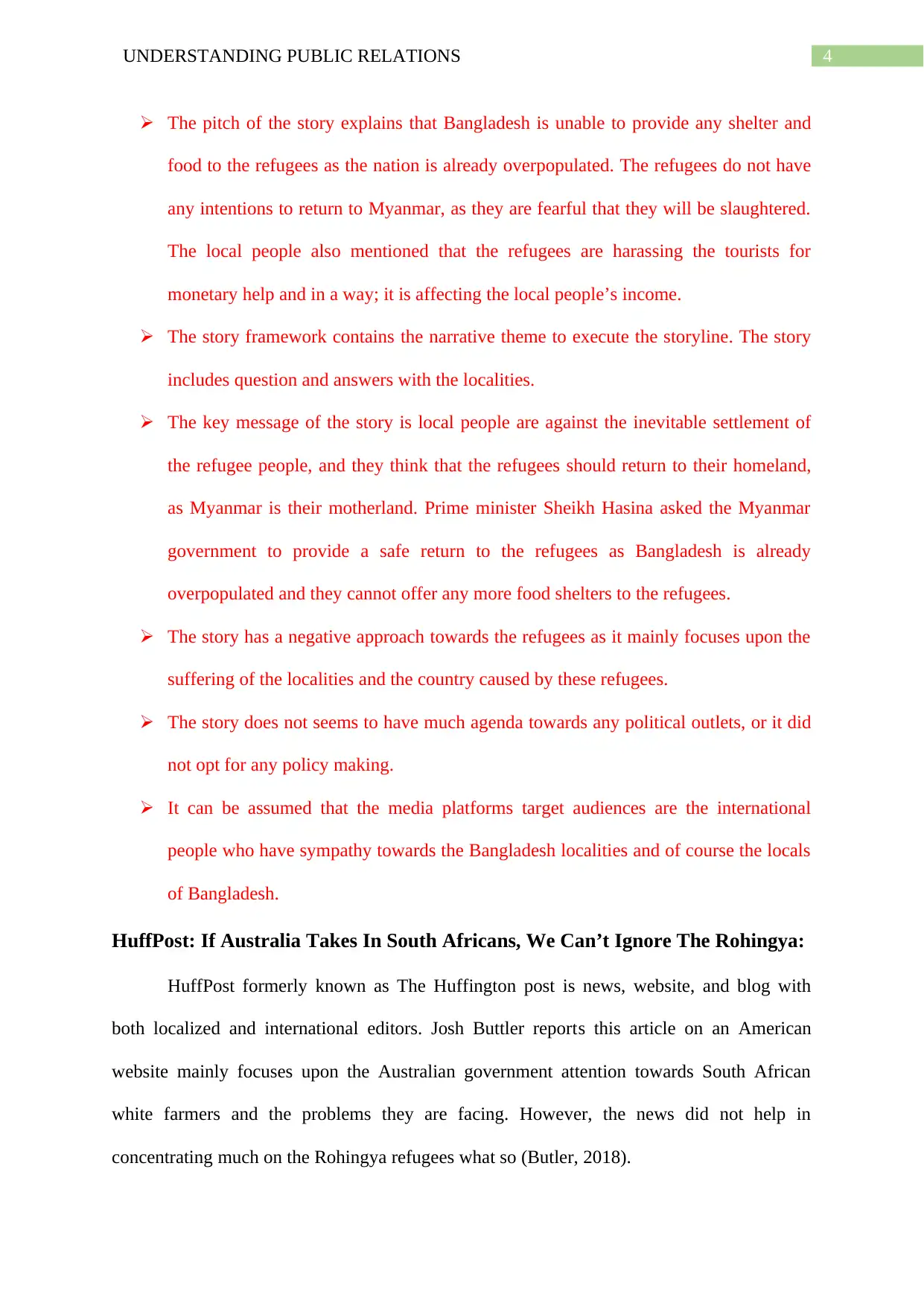
4UNDERSTANDING PUBLIC RELATIONS
The pitch of the story explains that Bangladesh is unable to provide any shelter and
food to the refugees as the nation is already overpopulated. The refugees do not have
any intentions to return to Myanmar, as they are fearful that they will be slaughtered.
The local people also mentioned that the refugees are harassing the tourists for
monetary help and in a way; it is affecting the local people’s income.
The story framework contains the narrative theme to execute the storyline. The story
includes question and answers with the localities.
The key message of the story is local people are against the inevitable settlement of
the refugee people, and they think that the refugees should return to their homeland,
as Myanmar is their motherland. Prime minister Sheikh Hasina asked the Myanmar
government to provide a safe return to the refugees as Bangladesh is already
overpopulated and they cannot offer any more food shelters to the refugees.
The story has a negative approach towards the refugees as it mainly focuses upon the
suffering of the localities and the country caused by these refugees.
The story does not seems to have much agenda towards any political outlets, or it did
not opt for any policy making.
It can be assumed that the media platforms target audiences are the international
people who have sympathy towards the Bangladesh localities and of course the locals
of Bangladesh.
HuffPost: If Australia Takes In South Africans, We Can’t Ignore The Rohingya:
HuffPost formerly known as The Huffington post is news, website, and blog with
both localized and international editors. Josh Buttler reports this article on an American
website mainly focuses upon the Australian government attention towards South African
white farmers and the problems they are facing. However, the news did not help in
concentrating much on the Rohingya refugees what so (Butler, 2018).
The pitch of the story explains that Bangladesh is unable to provide any shelter and
food to the refugees as the nation is already overpopulated. The refugees do not have
any intentions to return to Myanmar, as they are fearful that they will be slaughtered.
The local people also mentioned that the refugees are harassing the tourists for
monetary help and in a way; it is affecting the local people’s income.
The story framework contains the narrative theme to execute the storyline. The story
includes question and answers with the localities.
The key message of the story is local people are against the inevitable settlement of
the refugee people, and they think that the refugees should return to their homeland,
as Myanmar is their motherland. Prime minister Sheikh Hasina asked the Myanmar
government to provide a safe return to the refugees as Bangladesh is already
overpopulated and they cannot offer any more food shelters to the refugees.
The story has a negative approach towards the refugees as it mainly focuses upon the
suffering of the localities and the country caused by these refugees.
The story does not seems to have much agenda towards any political outlets, or it did
not opt for any policy making.
It can be assumed that the media platforms target audiences are the international
people who have sympathy towards the Bangladesh localities and of course the locals
of Bangladesh.
HuffPost: If Australia Takes In South Africans, We Can’t Ignore The Rohingya:
HuffPost formerly known as The Huffington post is news, website, and blog with
both localized and international editors. Josh Buttler reports this article on an American
website mainly focuses upon the Australian government attention towards South African
white farmers and the problems they are facing. However, the news did not help in
concentrating much on the Rohingya refugees what so (Butler, 2018).
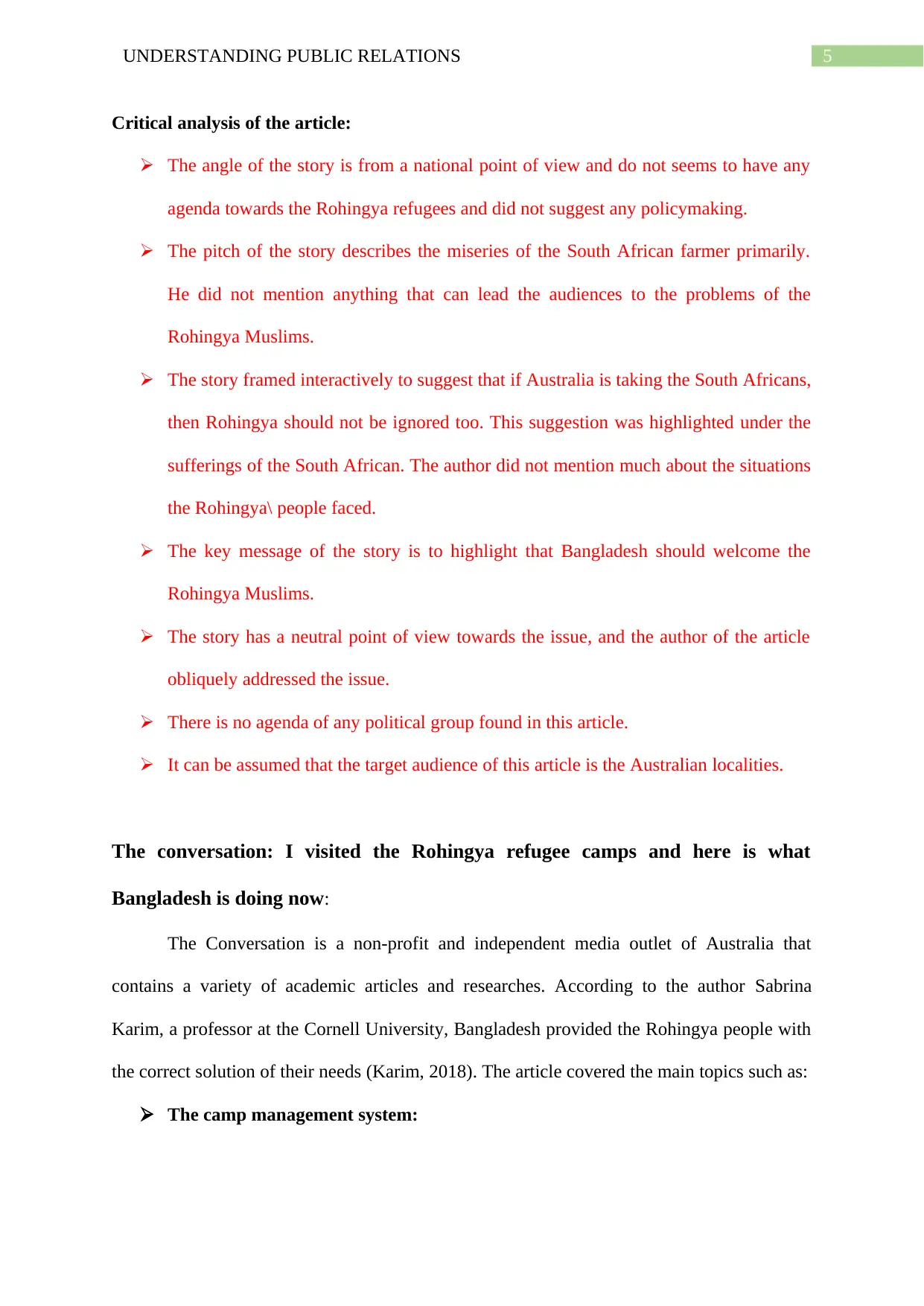
5UNDERSTANDING PUBLIC RELATIONS
Critical analysis of the article:
The angle of the story is from a national point of view and do not seems to have any
agenda towards the Rohingya refugees and did not suggest any policymaking.
The pitch of the story describes the miseries of the South African farmer primarily.
He did not mention anything that can lead the audiences to the problems of the
Rohingya Muslims.
The story framed interactively to suggest that if Australia is taking the South Africans,
then Rohingya should not be ignored too. This suggestion was highlighted under the
sufferings of the South African. The author did not mention much about the situations
the Rohingya\ people faced.
The key message of the story is to highlight that Bangladesh should welcome the
Rohingya Muslims.
The story has a neutral point of view towards the issue, and the author of the article
obliquely addressed the issue.
There is no agenda of any political group found in this article.
It can be assumed that the target audience of this article is the Australian localities.
The conversation: I visited the Rohingya refugee camps and here is what
Bangladesh is doing now:
The Conversation is a non-profit and independent media outlet of Australia that
contains a variety of academic articles and researches. According to the author Sabrina
Karim, a professor at the Cornell University, Bangladesh provided the Rohingya people with
the correct solution of their needs (Karim, 2018). The article covered the main topics such as:
The camp management system:
Critical analysis of the article:
The angle of the story is from a national point of view and do not seems to have any
agenda towards the Rohingya refugees and did not suggest any policymaking.
The pitch of the story describes the miseries of the South African farmer primarily.
He did not mention anything that can lead the audiences to the problems of the
Rohingya Muslims.
The story framed interactively to suggest that if Australia is taking the South Africans,
then Rohingya should not be ignored too. This suggestion was highlighted under the
sufferings of the South African. The author did not mention much about the situations
the Rohingya\ people faced.
The key message of the story is to highlight that Bangladesh should welcome the
Rohingya Muslims.
The story has a neutral point of view towards the issue, and the author of the article
obliquely addressed the issue.
There is no agenda of any political group found in this article.
It can be assumed that the target audience of this article is the Australian localities.
The conversation: I visited the Rohingya refugee camps and here is what
Bangladesh is doing now:
The Conversation is a non-profit and independent media outlet of Australia that
contains a variety of academic articles and researches. According to the author Sabrina
Karim, a professor at the Cornell University, Bangladesh provided the Rohingya people with
the correct solution of their needs (Karim, 2018). The article covered the main topics such as:
The camp management system:
⊘ This is a preview!⊘
Do you want full access?
Subscribe today to unlock all pages.

Trusted by 1+ million students worldwide
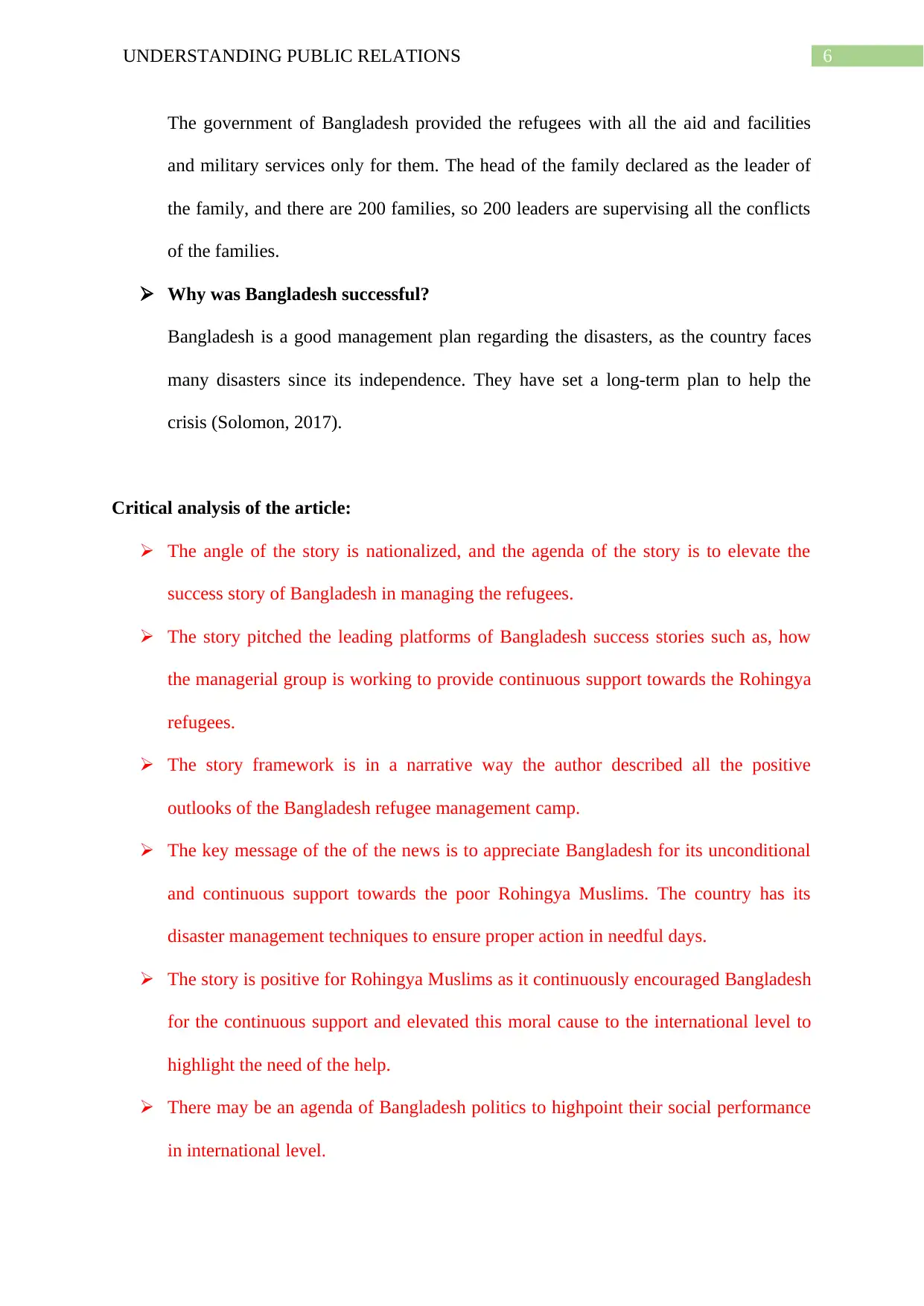
6UNDERSTANDING PUBLIC RELATIONS
The government of Bangladesh provided the refugees with all the aid and facilities
and military services only for them. The head of the family declared as the leader of
the family, and there are 200 families, so 200 leaders are supervising all the conflicts
of the families.
Why was Bangladesh successful?
Bangladesh is a good management plan regarding the disasters, as the country faces
many disasters since its independence. They have set a long-term plan to help the
crisis (Solomon, 2017).
Critical analysis of the article:
The angle of the story is nationalized, and the agenda of the story is to elevate the
success story of Bangladesh in managing the refugees.
The story pitched the leading platforms of Bangladesh success stories such as, how
the managerial group is working to provide continuous support towards the Rohingya
refugees.
The story framework is in a narrative way the author described all the positive
outlooks of the Bangladesh refugee management camp.
The key message of the of the news is to appreciate Bangladesh for its unconditional
and continuous support towards the poor Rohingya Muslims. The country has its
disaster management techniques to ensure proper action in needful days.
The story is positive for Rohingya Muslims as it continuously encouraged Bangladesh
for the continuous support and elevated this moral cause to the international level to
highlight the need of the help.
There may be an agenda of Bangladesh politics to highpoint their social performance
in international level.
The government of Bangladesh provided the refugees with all the aid and facilities
and military services only for them. The head of the family declared as the leader of
the family, and there are 200 families, so 200 leaders are supervising all the conflicts
of the families.
Why was Bangladesh successful?
Bangladesh is a good management plan regarding the disasters, as the country faces
many disasters since its independence. They have set a long-term plan to help the
crisis (Solomon, 2017).
Critical analysis of the article:
The angle of the story is nationalized, and the agenda of the story is to elevate the
success story of Bangladesh in managing the refugees.
The story pitched the leading platforms of Bangladesh success stories such as, how
the managerial group is working to provide continuous support towards the Rohingya
refugees.
The story framework is in a narrative way the author described all the positive
outlooks of the Bangladesh refugee management camp.
The key message of the of the news is to appreciate Bangladesh for its unconditional
and continuous support towards the poor Rohingya Muslims. The country has its
disaster management techniques to ensure proper action in needful days.
The story is positive for Rohingya Muslims as it continuously encouraged Bangladesh
for the continuous support and elevated this moral cause to the international level to
highlight the need of the help.
There may be an agenda of Bangladesh politics to highpoint their social performance
in international level.
Paraphrase This Document
Need a fresh take? Get an instant paraphrase of this document with our AI Paraphraser
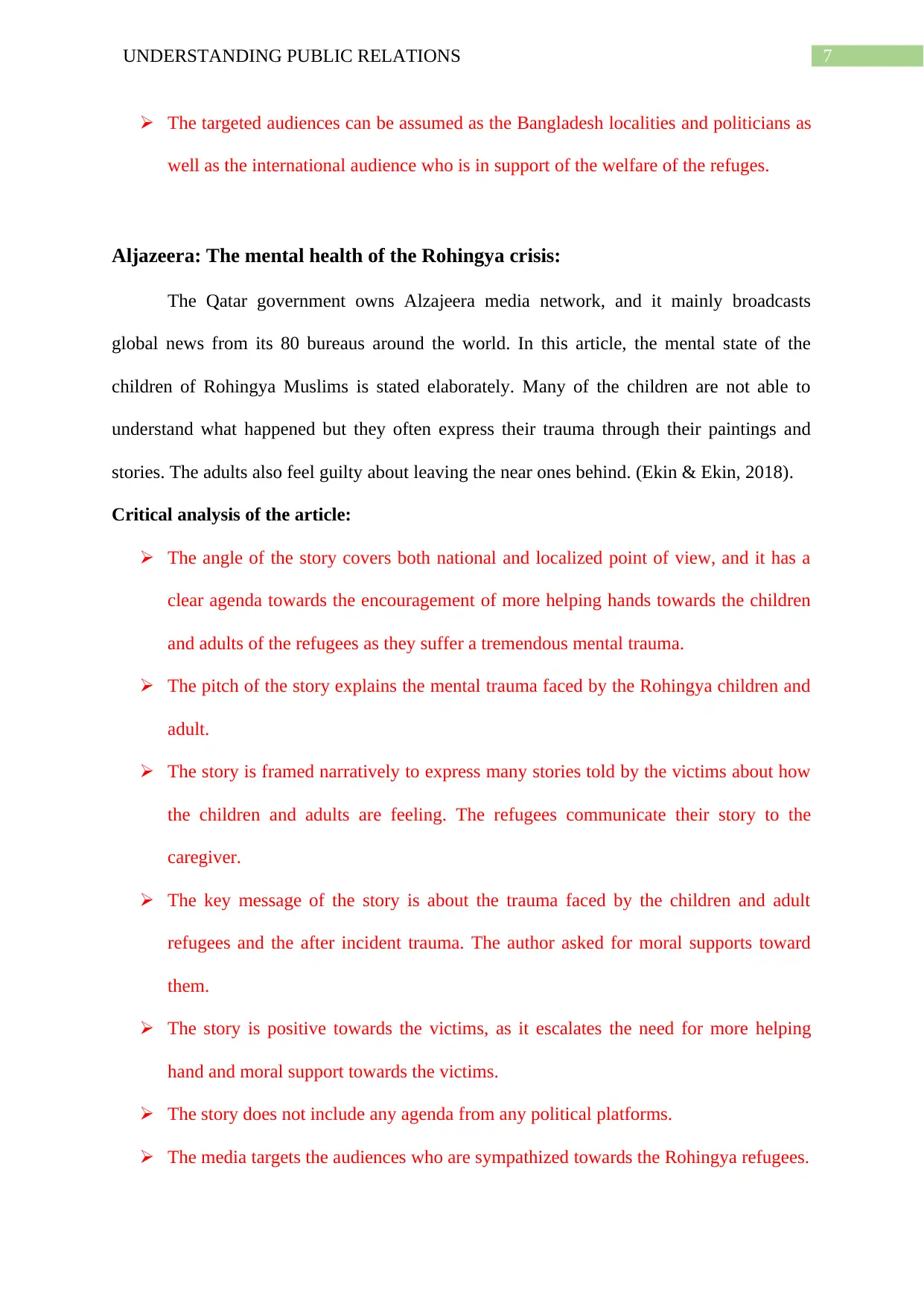
7UNDERSTANDING PUBLIC RELATIONS
The targeted audiences can be assumed as the Bangladesh localities and politicians as
well as the international audience who is in support of the welfare of the refuges.
Aljazeera: The mental health of the Rohingya crisis:
The Qatar government owns Alzajeera media network, and it mainly broadcasts
global news from its 80 bureaus around the world. In this article, the mental state of the
children of Rohingya Muslims is stated elaborately. Many of the children are not able to
understand what happened but they often express their trauma through their paintings and
stories. The adults also feel guilty about leaving the near ones behind. (Ekin & Ekin, 2018).
Critical analysis of the article:
The angle of the story covers both national and localized point of view, and it has a
clear agenda towards the encouragement of more helping hands towards the children
and adults of the refugees as they suffer a tremendous mental trauma.
The pitch of the story explains the mental trauma faced by the Rohingya children and
adult.
The story is framed narratively to express many stories told by the victims about how
the children and adults are feeling. The refugees communicate their story to the
caregiver.
The key message of the story is about the trauma faced by the children and adult
refugees and the after incident trauma. The author asked for moral supports toward
them.
The story is positive towards the victims, as it escalates the need for more helping
hand and moral support towards the victims.
The story does not include any agenda from any political platforms.
The media targets the audiences who are sympathized towards the Rohingya refugees.
The targeted audiences can be assumed as the Bangladesh localities and politicians as
well as the international audience who is in support of the welfare of the refuges.
Aljazeera: The mental health of the Rohingya crisis:
The Qatar government owns Alzajeera media network, and it mainly broadcasts
global news from its 80 bureaus around the world. In this article, the mental state of the
children of Rohingya Muslims is stated elaborately. Many of the children are not able to
understand what happened but they often express their trauma through their paintings and
stories. The adults also feel guilty about leaving the near ones behind. (Ekin & Ekin, 2018).
Critical analysis of the article:
The angle of the story covers both national and localized point of view, and it has a
clear agenda towards the encouragement of more helping hands towards the children
and adults of the refugees as they suffer a tremendous mental trauma.
The pitch of the story explains the mental trauma faced by the Rohingya children and
adult.
The story is framed narratively to express many stories told by the victims about how
the children and adults are feeling. The refugees communicate their story to the
caregiver.
The key message of the story is about the trauma faced by the children and adult
refugees and the after incident trauma. The author asked for moral supports toward
them.
The story is positive towards the victims, as it escalates the need for more helping
hand and moral support towards the victims.
The story does not include any agenda from any political platforms.
The media targets the audiences who are sympathized towards the Rohingya refugees.
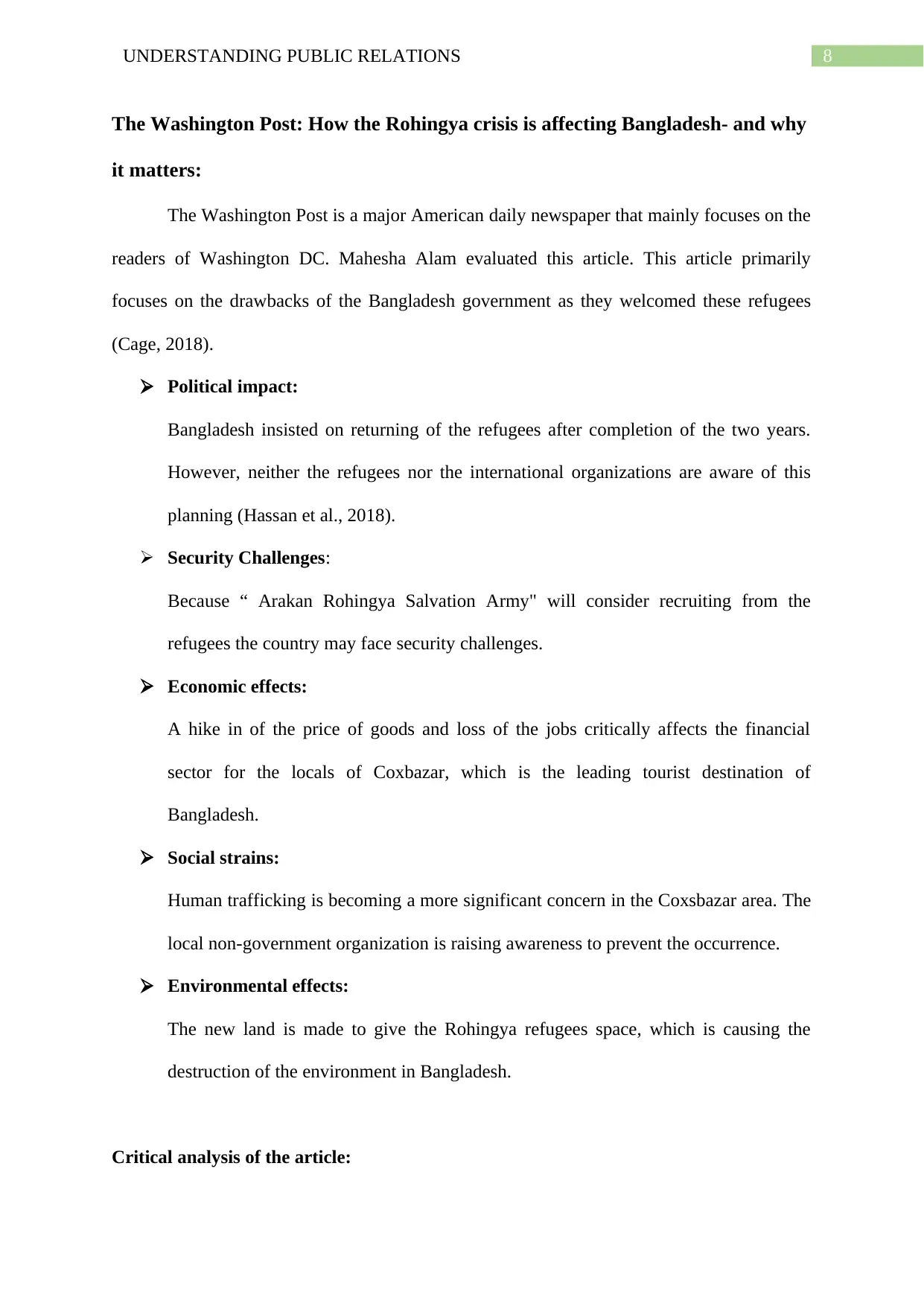
8UNDERSTANDING PUBLIC RELATIONS
The Washington Post: How the Rohingya crisis is affecting Bangladesh- and why
it matters:
The Washington Post is a major American daily newspaper that mainly focuses on the
readers of Washington DC. Mahesha Alam evaluated this article. This article primarily
focuses on the drawbacks of the Bangladesh government as they welcomed these refugees
(Cage, 2018).
Political impact:
Bangladesh insisted on returning of the refugees after completion of the two years.
However, neither the refugees nor the international organizations are aware of this
planning (Hassan et al., 2018).
Security Challenges:
Because “ Arakan Rohingya Salvation Army" will consider recruiting from the
refugees the country may face security challenges.
Economic effects:
A hike in of the price of goods and loss of the jobs critically affects the financial
sector for the locals of Coxbazar, which is the leading tourist destination of
Bangladesh.
Social strains:
Human trafficking is becoming a more significant concern in the Coxsbazar area. The
local non-government organization is raising awareness to prevent the occurrence.
Environmental effects:
The new land is made to give the Rohingya refugees space, which is causing the
destruction of the environment in Bangladesh.
Critical analysis of the article:
The Washington Post: How the Rohingya crisis is affecting Bangladesh- and why
it matters:
The Washington Post is a major American daily newspaper that mainly focuses on the
readers of Washington DC. Mahesha Alam evaluated this article. This article primarily
focuses on the drawbacks of the Bangladesh government as they welcomed these refugees
(Cage, 2018).
Political impact:
Bangladesh insisted on returning of the refugees after completion of the two years.
However, neither the refugees nor the international organizations are aware of this
planning (Hassan et al., 2018).
Security Challenges:
Because “ Arakan Rohingya Salvation Army" will consider recruiting from the
refugees the country may face security challenges.
Economic effects:
A hike in of the price of goods and loss of the jobs critically affects the financial
sector for the locals of Coxbazar, which is the leading tourist destination of
Bangladesh.
Social strains:
Human trafficking is becoming a more significant concern in the Coxsbazar area. The
local non-government organization is raising awareness to prevent the occurrence.
Environmental effects:
The new land is made to give the Rohingya refugees space, which is causing the
destruction of the environment in Bangladesh.
Critical analysis of the article:
⊘ This is a preview!⊘
Do you want full access?
Subscribe today to unlock all pages.

Trusted by 1+ million students worldwide
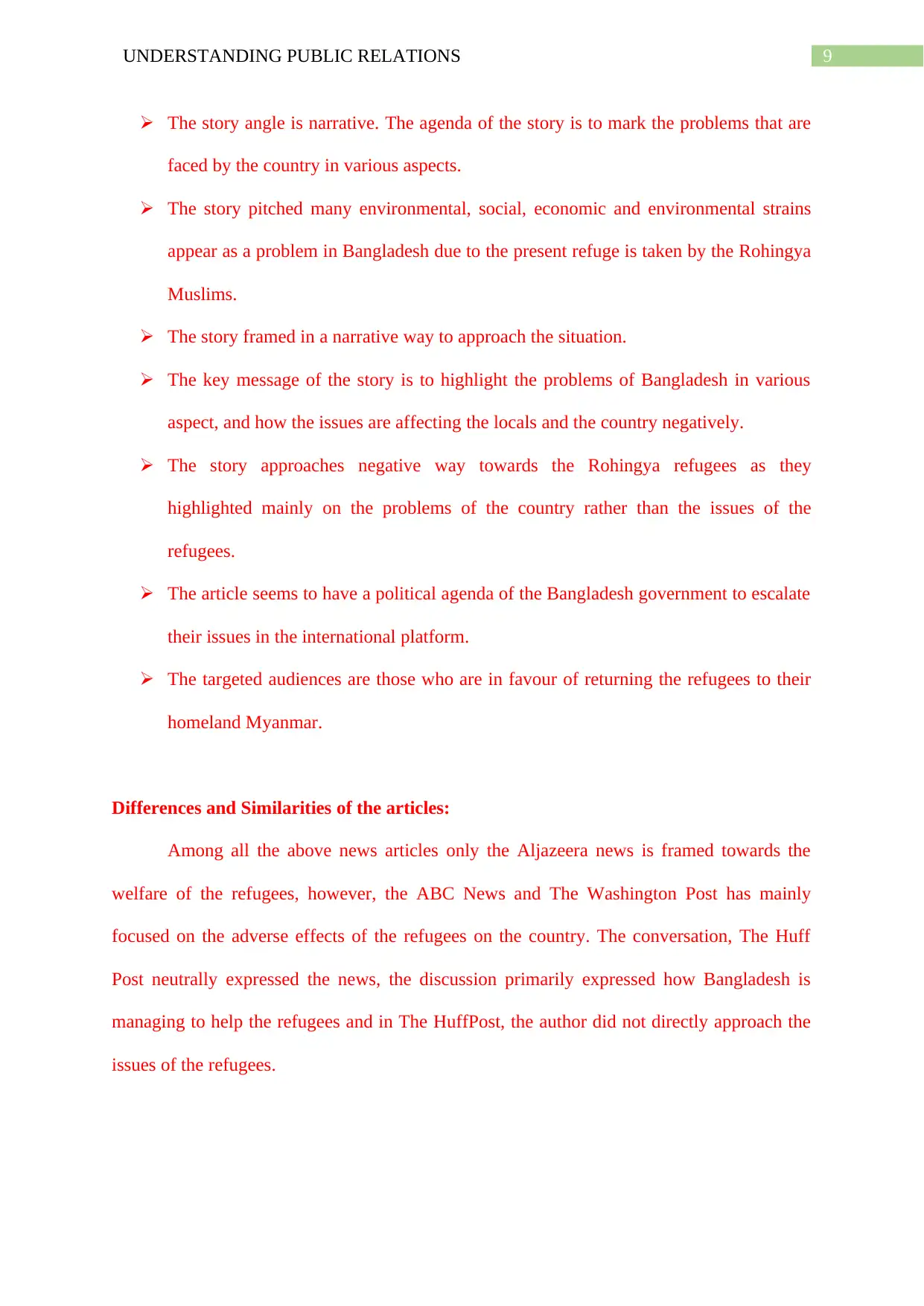
9UNDERSTANDING PUBLIC RELATIONS
The story angle is narrative. The agenda of the story is to mark the problems that are
faced by the country in various aspects.
The story pitched many environmental, social, economic and environmental strains
appear as a problem in Bangladesh due to the present refuge is taken by the Rohingya
Muslims.
The story framed in a narrative way to approach the situation.
The key message of the story is to highlight the problems of Bangladesh in various
aspect, and how the issues are affecting the locals and the country negatively.
The story approaches negative way towards the Rohingya refugees as they
highlighted mainly on the problems of the country rather than the issues of the
refugees.
The article seems to have a political agenda of the Bangladesh government to escalate
their issues in the international platform.
The targeted audiences are those who are in favour of returning the refugees to their
homeland Myanmar.
Differences and Similarities of the articles:
Among all the above news articles only the Aljazeera news is framed towards the
welfare of the refugees, however, the ABC News and The Washington Post has mainly
focused on the adverse effects of the refugees on the country. The conversation, The Huff
Post neutrally expressed the news, the discussion primarily expressed how Bangladesh is
managing to help the refugees and in The HuffPost, the author did not directly approach the
issues of the refugees.
The story angle is narrative. The agenda of the story is to mark the problems that are
faced by the country in various aspects.
The story pitched many environmental, social, economic and environmental strains
appear as a problem in Bangladesh due to the present refuge is taken by the Rohingya
Muslims.
The story framed in a narrative way to approach the situation.
The key message of the story is to highlight the problems of Bangladesh in various
aspect, and how the issues are affecting the locals and the country negatively.
The story approaches negative way towards the Rohingya refugees as they
highlighted mainly on the problems of the country rather than the issues of the
refugees.
The article seems to have a political agenda of the Bangladesh government to escalate
their issues in the international platform.
The targeted audiences are those who are in favour of returning the refugees to their
homeland Myanmar.
Differences and Similarities of the articles:
Among all the above news articles only the Aljazeera news is framed towards the
welfare of the refugees, however, the ABC News and The Washington Post has mainly
focused on the adverse effects of the refugees on the country. The conversation, The Huff
Post neutrally expressed the news, the discussion primarily expressed how Bangladesh is
managing to help the refugees and in The HuffPost, the author did not directly approach the
issues of the refugees.
Paraphrase This Document
Need a fresh take? Get an instant paraphrase of this document with our AI Paraphraser
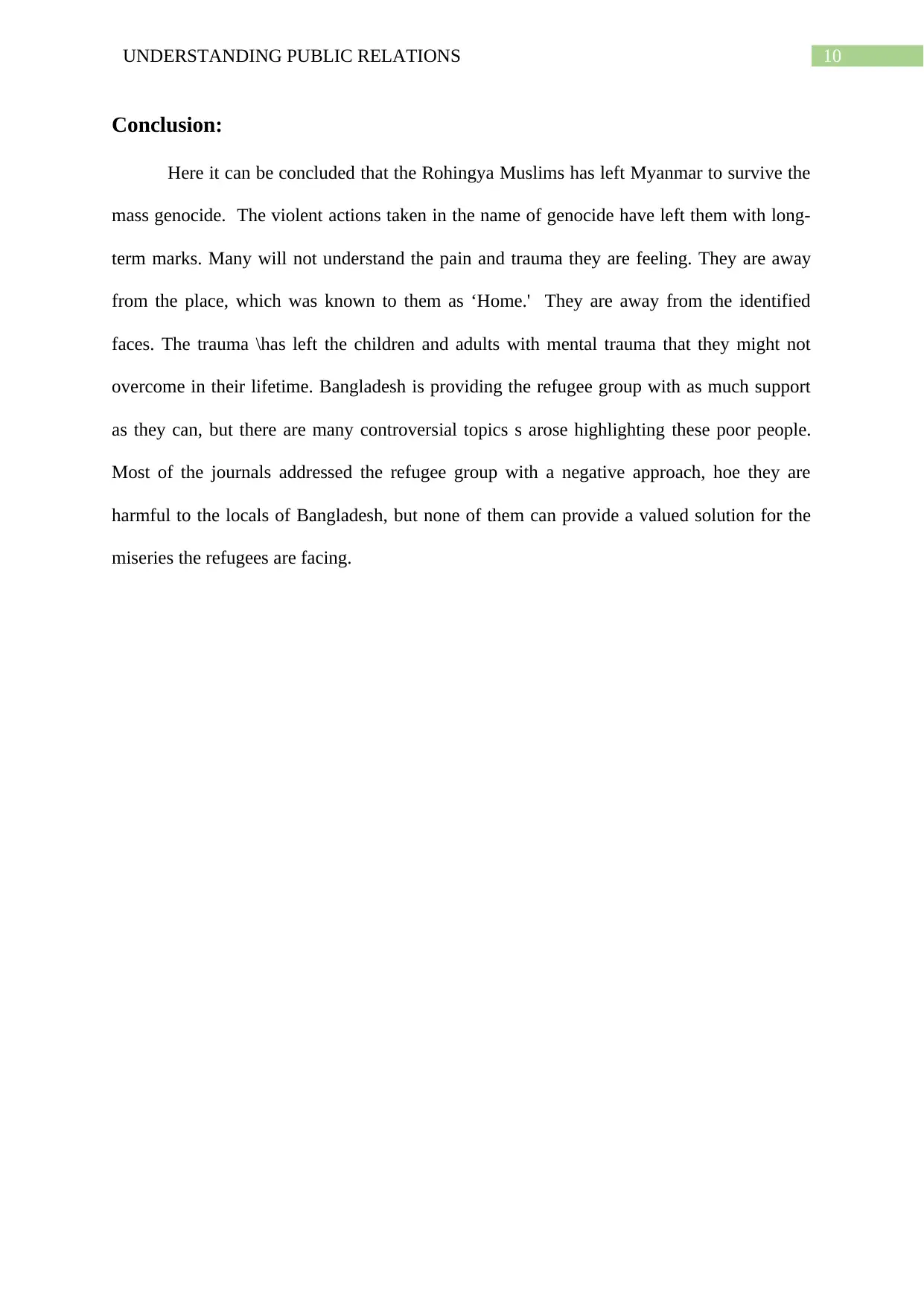
10UNDERSTANDING PUBLIC RELATIONS
Conclusion:
Here it can be concluded that the Rohingya Muslims has left Myanmar to survive the
mass genocide. The violent actions taken in the name of genocide have left them with long-
term marks. Many will not understand the pain and trauma they are feeling. They are away
from the place, which was known to them as ‘Home.' They are away from the identified
faces. The trauma \has left the children and adults with mental trauma that they might not
overcome in their lifetime. Bangladesh is providing the refugee group with as much support
as they can, but there are many controversial topics s arose highlighting these poor people.
Most of the journals addressed the refugee group with a negative approach, hoe they are
harmful to the locals of Bangladesh, but none of them can provide a valued solution for the
miseries the refugees are facing.
Conclusion:
Here it can be concluded that the Rohingya Muslims has left Myanmar to survive the
mass genocide. The violent actions taken in the name of genocide have left them with long-
term marks. Many will not understand the pain and trauma they are feeling. They are away
from the place, which was known to them as ‘Home.' They are away from the identified
faces. The trauma \has left the children and adults with mental trauma that they might not
overcome in their lifetime. Bangladesh is providing the refugee group with as much support
as they can, but there are many controversial topics s arose highlighting these poor people.
Most of the journals addressed the refugee group with a negative approach, hoe they are
harmful to the locals of Bangladesh, but none of them can provide a valued solution for the
miseries the refugees are facing.
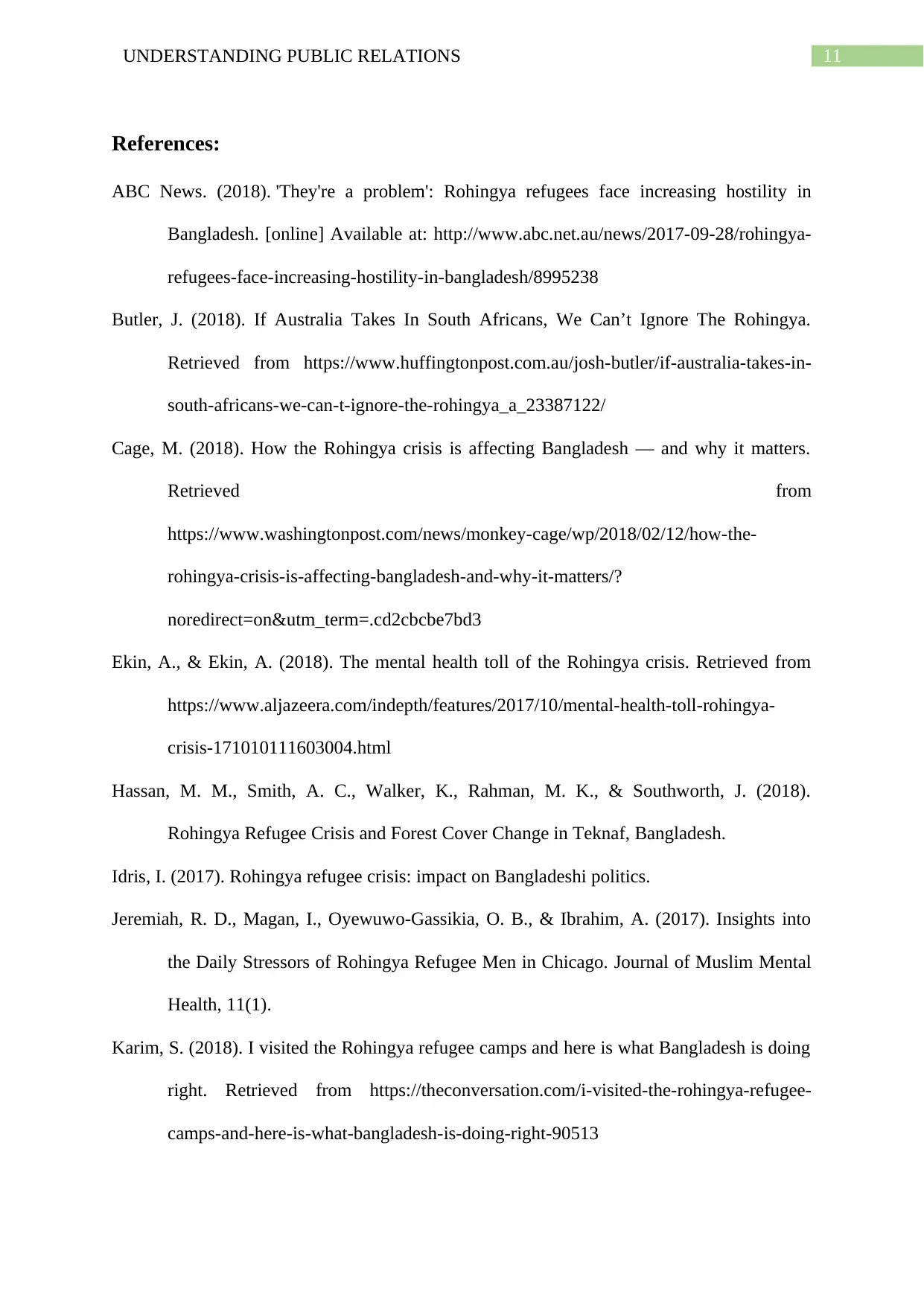
11UNDERSTANDING PUBLIC RELATIONS
References:
ABC News. (2018). 'They're a problem': Rohingya refugees face increasing hostility in
Bangladesh. [online] Available at: http://www.abc.net.au/news/2017-09-28/rohingya-
refugees-face-increasing-hostility-in-bangladesh/8995238
Butler, J. (2018). If Australia Takes In South Africans, We Can’t Ignore The Rohingya.
Retrieved from https://www.huffingtonpost.com.au/josh-butler/if-australia-takes-in-
south-africans-we-can-t-ignore-the-rohingya_a_23387122/
Cage, M. (2018). How the Rohingya crisis is affecting Bangladesh — and why it matters.
Retrieved from
https://www.washingtonpost.com/news/monkey-cage/wp/2018/02/12/how-the-
rohingya-crisis-is-affecting-bangladesh-and-why-it-matters/?
noredirect=on&utm_term=.cd2cbcbe7bd3
Ekin, A., & Ekin, A. (2018). The mental health toll of the Rohingya crisis. Retrieved from
https://www.aljazeera.com/indepth/features/2017/10/mental-health-toll-rohingya-
crisis-171010111603004.html
Hassan, M. M., Smith, A. C., Walker, K., Rahman, M. K., & Southworth, J. (2018).
Rohingya Refugee Crisis and Forest Cover Change in Teknaf, Bangladesh.
Idris, I. (2017). Rohingya refugee crisis: impact on Bangladeshi politics.
Jeremiah, R. D., Magan, I., Oyewuwo-Gassikia, O. B., & Ibrahim, A. (2017). Insights into
the Daily Stressors of Rohingya Refugee Men in Chicago. Journal of Muslim Mental
Health, 11(1).
Karim, S. (2018). I visited the Rohingya refugee camps and here is what Bangladesh is doing
right. Retrieved from https://theconversation.com/i-visited-the-rohingya-refugee-
camps-and-here-is-what-bangladesh-is-doing-right-90513
References:
ABC News. (2018). 'They're a problem': Rohingya refugees face increasing hostility in
Bangladesh. [online] Available at: http://www.abc.net.au/news/2017-09-28/rohingya-
refugees-face-increasing-hostility-in-bangladesh/8995238
Butler, J. (2018). If Australia Takes In South Africans, We Can’t Ignore The Rohingya.
Retrieved from https://www.huffingtonpost.com.au/josh-butler/if-australia-takes-in-
south-africans-we-can-t-ignore-the-rohingya_a_23387122/
Cage, M. (2018). How the Rohingya crisis is affecting Bangladesh — and why it matters.
Retrieved from
https://www.washingtonpost.com/news/monkey-cage/wp/2018/02/12/how-the-
rohingya-crisis-is-affecting-bangladesh-and-why-it-matters/?
noredirect=on&utm_term=.cd2cbcbe7bd3
Ekin, A., & Ekin, A. (2018). The mental health toll of the Rohingya crisis. Retrieved from
https://www.aljazeera.com/indepth/features/2017/10/mental-health-toll-rohingya-
crisis-171010111603004.html
Hassan, M. M., Smith, A. C., Walker, K., Rahman, M. K., & Southworth, J. (2018).
Rohingya Refugee Crisis and Forest Cover Change in Teknaf, Bangladesh.
Idris, I. (2017). Rohingya refugee crisis: impact on Bangladeshi politics.
Jeremiah, R. D., Magan, I., Oyewuwo-Gassikia, O. B., & Ibrahim, A. (2017). Insights into
the Daily Stressors of Rohingya Refugee Men in Chicago. Journal of Muslim Mental
Health, 11(1).
Karim, S. (2018). I visited the Rohingya refugee camps and here is what Bangladesh is doing
right. Retrieved from https://theconversation.com/i-visited-the-rohingya-refugee-
camps-and-here-is-what-bangladesh-is-doing-right-90513
⊘ This is a preview!⊘
Do you want full access?
Subscribe today to unlock all pages.

Trusted by 1+ million students worldwide
1 out of 13
Your All-in-One AI-Powered Toolkit for Academic Success.
+13062052269
info@desklib.com
Available 24*7 on WhatsApp / Email
![[object Object]](/_next/static/media/star-bottom.7253800d.svg)
Unlock your academic potential
Copyright © 2020–2025 A2Z Services. All Rights Reserved. Developed and managed by ZUCOL.
